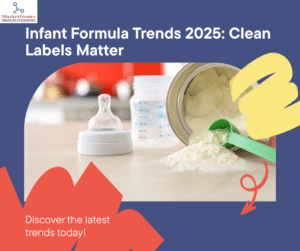In 2025, the global infant formula industry is undergoing a major shift. As parents become increasingly informed and selective, manufacturers are aligning their offerings to meet demands for clean label transparency, functional benefits, and region-specific formulations. This evolution in infant nutrition is not just a passing trend it’s a long-term response to deeper changes in parental expectations, regulatory frameworks, and global market dynamics. Let’s read MarketGenics analysis on the Market.
Clean labeling in infant formula refers to the use of simple, recognizable, and natural ingredients without artificial additives, synthetic preservatives, GMOs, or unnecessary fillers. In today’s hyper-aware consumer landscape, especially among millennial and Gen Z parents, product transparency is non-negotiable. Consumers want to know where ingredients come from, how they’re processed, and whether they are sustainably sourced.
A survey by MarketGenics tells that nearly 85% of global consumers believe it is important for product labels to list ingredients they recognize and understand. This demand is particularly strong in Europe and North America, where consumer protection regulations also reinforce these preferences.

2. Supply Chain Limitations for Organic and Minimal-Processing Inputs:
Sourcing high-quality organic and minimally processed ingredients (e.g., organic lactose, grass-fed milk) at scale is difficult. This limits scalability and increases product cost.
3. Affordability vs. Premiumization: Clean label and regionally tailored formulas tend to be more expensive due to ingredient sourcing and compliance costs creating disparities in access, especially in low- and middle-income countries.
4. Data-Driven Localization and Product Adaptation: Adapting formulas to local dietary norms, allergens, and cultural preferences requires localized research and investment which can be a challenge for Small or new brands.
5. Sustainability Pressures: Clean label ingredients and regional sourcing must also meet rising sustainability standards (e.g., carbon footprint, ethical sourcing) which adds an additional layer of complexity and cost to product development and packaging.
6. Counterfeit and Unregulated Market Risks: Especially in regions with limited oversight, demand for premium clean-label formula has driven a rise in counterfeits or parallel imports.
In 2023, several infant nutrition brands operating across the EU shifted their entire product lines to organic-certified and minimally processed formulas in response to Regulation (EU) 2016/127, which enforces strict composition rules for infant formula and follow-on milk. As per MarketGenics, from 2025 to 2030, the organic baby food market in Europe is expected to expand at a compound annual growth rate (CAGR) of around 7%, reaching a value of about USD 1.77 billion.
Modern parents are looking beyond calories and basic nutrition they want functional health benefits such as immune support, cognitive development, and improved digestion. While these needs are often addressed using DHA, ARA, probiotics, prebiotics, and other fortifying ingredients, today’s consumers also expect these components to be naturally derived and cleanly processed.
For instance, formulas now increasingly include human milk oligosaccharides (HMOs) complex carbohydrates found in breast milk that foster healthy gut flora. Innovations in biotechnology have made these ingredients more accessible and affordable, without compromising the clean label appeal.
Infant formula manufacturers are now tailoring products to meet regional health profiles, dietary customs, and allergen concerns.
As per MarketGenics, between 2021 and 2024, sales of lactose-reduced and soy-free infant formulas surged across East Asia, particularly in Japan and South Korea. Local companies responded by launching new formulas incorporating rice protein isolates and goat milk, aligning with both traditional preferences and digestive health concerns in the region.
The global infant formula market is projected to exceed around USD 90 billion by the end of 2025, growing at a CAGR ranging between 9.5% and 10.5% from 2024 to 2034. Clean label and regionally tailored products are expected to account for nearly 45% of new product launches globally.
The market is expanding rapidly in both developed and developing economies. Factors such as dual-income households, growing urban populations, and improved retail access in emerging nations are contributing to a broader consumer base.
A multinational infant formula brand entered several African markets in 2023 with a tailored formula that required no refrigeration, used locally sourced dairy, and adhered to regional nutrient deficiency guidelines. By 2024, their sales in West Africa had tripled, largely due to the alignment of product design with regional needs and infrastructure challenges.
Governments across the globe are tightening infant nutrition standards:
These regulations further reinforce clean label and region-specific strategies as a
The global infant formula market in 2025 is not just growing it’s transforming. With clean labels now considered a baseline, companies must offer science-backed, functionally enriched, and regionally tailored products to meet the new standard. Success in this competitive space will belong to brands that champion transparency, ethical sourcing, and cultural responsiveness. As parenting norms evolve and nutritional science advances, the infant formula industry must stay ahead with products that reflect both modern values and local relevance.
MarketGenics can be a very helpful source for an infant food company by delivering deep consumer insights and market intelligence to guide product innovation, regulatory alignment, and region-specific branding strategies.

MarketGenics India is a MRSI certified company.
Send us your resume at
info@marketgenics.co
© 2025 MarketGenics India Pvt Ltd.; All rights reserved